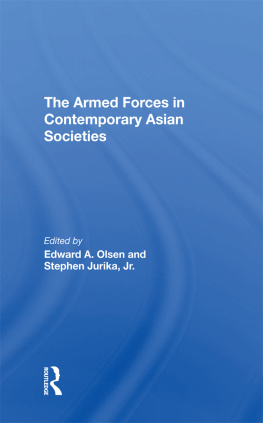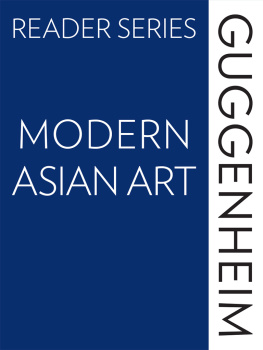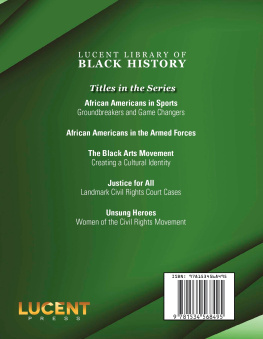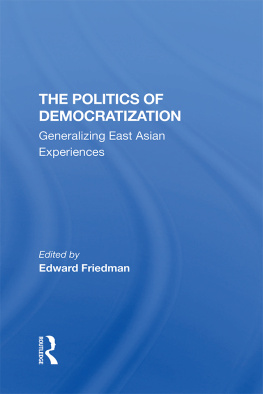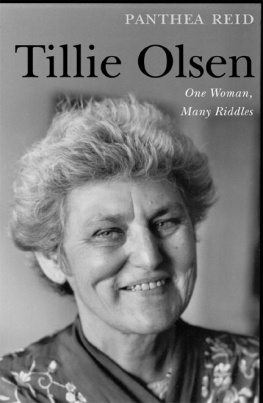The Armed Forces in Contemporary Asian Societies
About the Book and Editors
This book integrates current knowledge about the military, political, economic, and cultural roles of the armed forces in sixteen Asian countries, examining the interplay of these factors and their bearing on each society's civil-military relations. The authors explore the history, current status, and potential future course of each country. Analyzing all key Asian armed forces, they provide a comprehensive view of the military's domestic rolea crucial factor in assessing the foreign and defense policy options facing Asia as a whole.
Edward A. Olsen is associate professor of national security affairs and coordinator of Asian-Pacific Studies at the U.S. Naval Postgraduate School. Stephen Jorika, Jr., is adjunct professor of national security affairs at the school.
The Armed Forces in Contemporary Asian Societies
edited by Edward A. Olsen and Stephen Jurika, Jr.
First published 1986 by Westview Press, Inc.
Published 2019 by Routledge
52 Vanderbilt Avenue, New York, NY 10017
2 Park Square, Milton Park, Abingdon, Oxon OX14 4RN
Routledge is an imprint of the Taylor & Francis Group, an informa business
Copyright 1986 Taylor & Francis
All rights reserved. No part of this book may be reprinted or reproduced or utilised in any form or by any electronic, mechanical, or other means, now known or hereafter invented, including photocopying and recording, or in any information storage or retrieval system, without permission in writing from the publishers.
Notice:
Product or corporate names may be trademarks or registered trademarks, and are used only for identification and explanation without intent to infringe.
Library of Congress Catalogin in Publication Data
Main entry under title:
The Armed forces in contemporary Asian societies.
(Westview special studies in military affairs)
Bibliography: p.
1. AsiaArmed ForcesHistory20th centuryAd
dresses, essays, lectures. 2. Sociology, MilitaryAsia
History20th centuryAddresses, essays, lectures.
3. Civil-military relationsAsiaHistory20th century
Addresses, essays, lectures. 4. AsiaArmed Forces
Military activityAddresses, essays, lectures.
I. Olsen, Edward A. II. Jurika, Stephen. III. Series.
UA830.A764 1986 306'.27'095 85-688
ISBN 13: 978-0-367-29021-4 (hbk)
Contents
, Edward A. Olsen and Stephen Jurika, Jr.
, June Teufel Dreyer
, Edward W. Ross
, James H. Buck
, Edward A. Olsen
, Gregory F. T. Winn
, Douglas Pike
, David Morell
, Robert L. Rau
, Patrick M. Mayerchak
, Harold W. Maynard
, William E. Berry, Jr.
, Jon A. Wiant
, Glynn L. Wood.
, Stephen Philip Cohen
, Jeffrey Lunstead
, Ralph H. Magnus
, Sheldon W. Simon
Guide
Edward A. Olsen
Stephen Jurika , Jr.
There are many published studies of Asian security affairs available. As Asia's strategic importance becomes more evident to Westerners due to its population, economic prowess, and power, such studies are certain to proliferate. The present study does not focus on the international political, economic, or military affairs of Asia but on the domestic role of Asian armed forces in contemporary Asian societies. Discrete studies of this type have been done previously, but never have studies of all the key Asian armed forcesfrom Northeast to South Asiabeen brought between two covers. This volume is an effort to fill that void and expand our understanding of this vital subject. Comprehending the dynamics of Asian armed forces' domestic roles is crucially important if we are to assess correctly the foreign and defense policy options on Asia's horizons. In this sense, the chapters in this volume provide collectively the basis for further research into contemporary Asian strategic affairs as well as insights into the military's role in the domestic affairs of individual countries.
All of the chapters are revisions of papers presented originally at a conference on "The Role of the Armed Forces in Contemporary Asia" held at the Naval Postgraduate School, Monterey, California in August 1982. The participants were chosen for their expertise in the political-military affairs of an Asian country. The countries addressed represent three sub-regions of Asia: East Asia (China, Taiwan, Japan, South Korea, and North Korea), Southeast Asia (Vietnam-Laos-Cambodia, Thailand, Burma, Indonesia, Malaysia, the Philippines, and Singapore), and South Asia (India, Pakistan, Bangladesh, and Afghanistan). Southwestern Asia, with the partial exception of Afghanistan, which falls into two categories, was excluded becauseas the "Near East"it is not popularly considered "Asia" in the context of the issues raised here. Central Asia, dominated by the Soviet Union with its essentially European military leadership, also was excluded on a similar basis.
The conference was part of a research project sponsored by the Naval Research Foundation. Subsequent assistance for preparing the papers for publication was provided by the Earhart Foundation. The editors and authors express their appreciation for this assistance, but the views remain solely those of the authors and not their employers or any of the sponsors.
Despite these exceptions, this volume represents an unusually comprehensive cross section of studies on Asia's armed forces. "Asian studies" frequently is a self-segregating field with little cross fertilization between, for example, East Asia and South Asia. Such academic barriers, though unfortunate, reflect the reality of contemporary Asian international affairs where longstanding cultural divisions remain between the Sinic and Indic realms. Bringing together specialists on somewhat disparate countries at once helps to underline the similarities and differences throughout Asia's experiences with its armed forces.
The contributors to this volume were provided a set of core questions for guidance and were asked to answer them for "their country." Not all questions applied to all the countries and no two authors responded in precisely the same way. Furthermore, the many idiosyncracies in this number of country studies precludes uniformity of narrative presentation. Despite this predisposition to diversity, there is a purposeful thread of unity connecting these chapters which gives the subject matter a set of common themes and identifies the commonalities in the societal roles of Asia's armed forces. We shall examine these themes to provide an integrated conceptual schema for the reader and a useful background for the separate chapters.
All of the chapters address the origins of the armed forces' status in their host society. This basically requires a two-fold approach, First, the armed forces' histories are surveyed to discern the importance of their colonial-era origins, the roles they played in the parent society's independence movement or search for nationalism, and the extent to which an armed anti-imperialism was metamorphosed into some variant of militarism. Second, the contemporary military roles of the armed forces are assessed in meeting the real strategic needs of the host society. This requires analysis of the external and internal threat perceptions which inform the society's elites and an examination of the offensive and defensive capabilities of the armed forces against country X's requirements, or the "guns versus butter" approach. In short, we attempt to clarify why the armed forces do or do not have political power and the societal clout that accrues from its possession.


